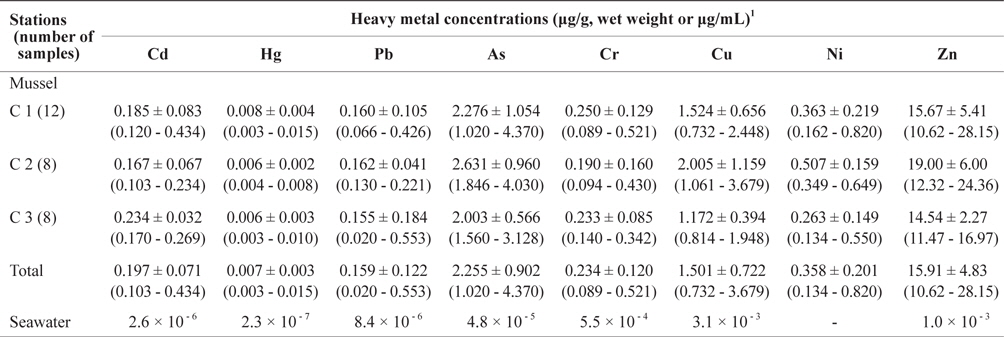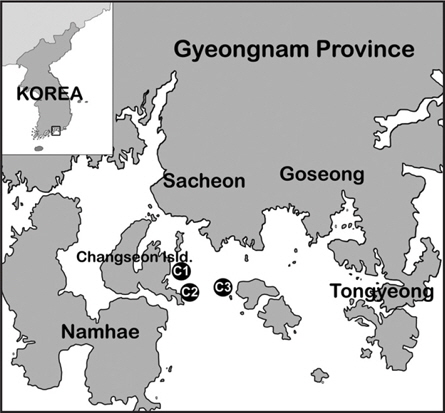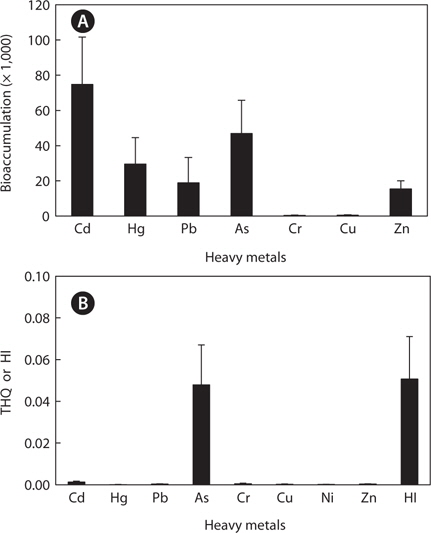



Fishery products are an important global food resource. According to the Food and Agriculture Organization of the United Nations (FAO, 2009), Korea was the world’s seventh greatest consumer of fishery products in 2009, accounting for 56.1 kg/person/year, which is three-fold higher than the global average consumption. FAO (2012) also reported that Korea produced 737,855 tons of molluscan shellfish in 2011, which ranked fourth in the world, accounting for almost 3.5% of global production. According to Statistics Korea (2013), the country produced 61,310 tons of mussels in 2012, the second largest amount of shellfish produced in Korea. Gyeongnam province produced the largest amount of mussel in Korea, accounting for about 85% of the mussel products in Korea. The Korean government has established a memorandum of understanding with the European Union (EU), and there are designated shellfish-cultivation areas for export along the southern coast of Korea that meet the standards set by the EU (Lee et al., 2011). The Changseon area, located in Gyeongnam province, has been the designated shellfish-cultivation area for export since 2009 because it is an important mussel-cultivation area in Korea (Ha et al., 2013). The products are consumed domestically or exported mainly to the EU (Mok et al., 2013). Therefore, the safety of Korean seafood is very important to Korea and importing countries, including the EU.
Heavy metals found naturally in the environment vary widely. Heavy metals such as arsenic (As), cadmium (Cd), chromium (Cr), copper (Cu), lead (Pb), mercury (Hg), nickel (Ni), and zinc (Zn) accumulate generally in marine organisms from the aquatic environment, especially in various species of molluscan shellfish (Kobal et al., 2004; Mora et al., 2004; Borak and Hosgood, 2007; Mok et al., 2010). Some hazardous metals (As, Cd, Cr, Hg, and Pb) that accumulate in molluscan shellfish pose a health risk to humans, even in trace amounts (EOS Ecology, 2012; Mok et al., 2014). To protect public health, Korean authorities have established regulatory limits and monitoring programs for three hazardous metals, namely, Cd, Pb, and Hg, to determine whether shellfish are safe to consume (KMFDS, 2014). Heavy metal contamination can be hazardous to humans; therefore, the concentrations of heavy metals in shellfish from the aquatic environment must be monitored regularly to provide information on the hazard levels for the consumer. The accumulation of heavy metals in marine organisms depends on both their uptake and elimination rates. Heavy metals are taken up through various organs and concentrated at different levels (Guven et al., 1999).
In the present study, we determined the concentration and bioaccumulation of heavy metals in the mussel
>
Reagents and standard solutions
Supra-pure grade nitric acid (Merck, Darmstadt, Germany) was used for sample preparation. Deionized water (DIW) was passed through a Milli-Q water purification system (Millipore, Billerica, MA, USA). Working standard solutions of Cd, Pb, As, Cr, Cu, Ni, and Zn were prepared by diluting 1,000 mg/L standard solutions (Merck, Darmstadt, Germany) in DIW for the calibration. MESS-3, a marine sediment certified reference 314material (CRM), was purchased from the National Research Council of Canada (NRCC, Ottawa, ON, Canada) and used as a calibration standard for Hg.
Samples were collected twice a year from 2008 through 2013 at fixed monitoring stations in the Changseon area, which is the designated shellfish-cultivation area for export, located on the southern coast of Korea (Fig. 1). In the Changseon area, 28 mussel samples
The mussel samples were immediately washed with tap water and DIW upon reception and the shells of the mussels were shucked. The tissue samples were cleaned with DIW, homogenized, and weighed. The homogenized tissues were freeze-dried with a vacuum freeze dryer (FDU-2100, EYELA, Tokyo, Japan) and then ground into powder for analysis. About 1.0 g powdered sample was placed in a 60 mL digestion vessel (Savillex, Eden Prairie, MN, USA), after which 20 mL nitric acid was added. The vessel was covered and left overnight at room temperature. The samples were digested with a heating digester (DigiPREP HP, SCP Science, Champlain, NY, USA), and more nitric acid was added to samples that were not completely digested. The completely digested samples were allowed to cool to room temperature, dissolved in 2% nitric acid, filtered (glass wool), and their volumes were increased to 100 mL 2% nitric acid to analyze all heavy metals, excluding Hg. Approximately 0.1 g homogenized sample was used for the Hg analysis.
All digested samples were analyzed in triplicate for Cd, Pb, As, Cr, Cu, Ni, and Zn using inductively coupled plasma mass spectrometry (ICP-MS; ELAN DRC II, PerkinElmer, Waltham, MA, USA). Total Hg concentration in homogenized samples was measured directly in triplicate with a combustion gold amalgamation method using a direct mercury analyzer (DMA-80, Milestone, Milano, Italy). The blanks, calibration standards, and CRMs were analyzed using the same methods. The concentrations of heavy metals were expressed in micrograms per gram of wet weight sample.
The accuracy of the heavy metal analysis method was assessed using the SRM-1566b (oyster tissue) CRM provided by the National Institute of Standards and Technology (NIST, Gaithersburg, MD). The quantitative recoveries of heavy metals in the oyster tissue CRM (
Statistical evaluation was conducted using analysis of variance (ANOVA) with the general linear model (GLM) procedure (version 9.2, SAS Institute, Cary, NC, USA). Duncan’s multiple-range test was applied to determine the significance of differences between the mean concentrations of heavy metals in the mussel samples.
>
Concentration and bioaccumulation of heavy metals in mussel
The mean, standard deviation, and range of concentrations of the heavy metals analyzed in the mussels collected from three fixed stations in the Changseon area are shown in Table 1. The selected metals have been monitored regularly in the designated shellfish-cultivation areas in the EU and Korea. The mean concentrations in mussel samples decreased significantly (

Heavy metal concentrations in the mussel Mytilus galloprovincialis and seawater collected from the Changseon area on the south coast in Korea
Some heavy metals such as Cd, Hg, Pb, As, and Cr can harm humans, even in trace amounts. The mean concentrations of As at each mussel station, which were the highest of the hazardous metals, ranged from 2.003 to 2.631 μg/g, with the highest found at station C2. The mean Cd concentrations in mussel samples at each station, which were the highest of the three hazardous metals (Cd, Pb, and Hg) within the regulatory limits established by Korea (KMFDS, 2014), ranged from 0.167 to 0.234 μg/g. The mean Cd concentration in all mussels from throughout the Changseon area was 0.197 μg/g, less than the 0.510 and 0.288 μg/g for shellfish reported by Sho et al. (2000) and Ham (2002), respectively, in Korea. Our result is slightly lower than the average levels of 0.22 and 0.224 μg/g for shellfish in India (Sivaperumal et al., 2007) and China (Li et al., 2013), respectively. All samples had Cd concentrations within the regulatory limits (1.0 to 2.0 μg/g) set by the Codex Alimentarius Commission (2.0 μg/g) (2006) and other countries such as Korea (2.0 μg/g) (KMFDS, 2014), Australia, New Zealand (both 2.0 μg/g) (FSANZ, 2008), and the EU (1.0 μg/g) (EC, 2001). The mean Hg concentrations of the samples at each station ranged from 0.006 to 0.008 μg/g, far lower than the limit (0.5 μg/g) in Korea (KMFDS, 2014) and the EU (EC, 2005). The mean level (0.007 μg/g) of Hg in all mussel samples was three- to four-fold lower than the levels for shellfish reported in other Korean studies (Ham, 2002; Sho et al., 2000). The mean Hg level was similar to the 0.008 μg/g reported for Chinese shellfish (Li et al., 2013).
The highest Pb concentration (0.553 μg/g) was about two- to four-fold lower than the regulatory limits (1.0 to 2.0 μg/g) set by various countries, e.g., 2.0 μg/g in Korea (KMFDS, 2014), Australia, and New Zealand (FSANZ, 2008) and 1.0 μg/g in the EU (EC, 2001). The Korean authority has established a memorandum of understanding with the EU; thus, the shellfish products harvested from the designated shellfish-cultivation areas (Changseon area, etc.) can only be exported to the EU (Lee et al., 2011). Therefore, because the heavy metals of mussels produced in the Changseon area meet the standards established by the EU, it is possible to export mussels to the EU.
The mean bioaccumulation ratios in all mussels from surrounding seawater ranged from 429- to 74,794-fold; the highest ratio was found for Cd (Fig. 2A). The metals in mussels accumulated in the order Cd > As > Hg > Pb > Zn > Cu > Cr; however, the differences between Pb and Zn and between Cr and Cu were not significant. The metal bioaccumulation ratio in mussels was relatively high for Cd, Hg, Pb, As, and Zn but low for Cr and Cu. The accumulation of contaminants in aquatic organisms depends on both their uptake and elimination rates (Guven et al., 1999). Heavy metals are taken up through various organs and concentrated at different levels in each organ (Bustamante et al., 2000; Sivaperumal et al., 2007; Abdallah, 2013).
Even trace concentrations of some heavy metals such as Cd, Hg, and Pb can harm humans. Korea has established regulatory limits and has monitoring programs for these three hazardous metals to protect the public that consumes fishery products (Mok et al., 2014). The concentration and bioaccumulation ratio of Cd were the highest of the three hazardous metals. The concentrations of these harmful metals in all samples were below the regulatory limits established by Korea, the EU, Australia, and New Zealand.
>
Dietary intake estimation and risk assessment of heavy metals via consumption of mussel
The EDIs of heavy metals represent the daily intake of heavy metals through the consumption of mussels for an adult. The EDI was compared to the PTDI proposed by the JECFA (1999; 2010a; 2010b) and the EPA (2013). The provisional tolerable weekly intake (PTWI) for Hg and Pb (JECFA, 1999; 2010a) and the provisional tolerable monthly intake (PTMI) for Cd (JECFA, 2010b) were established by the JECFA because of the risks of even trace concentrations of these metals to human health.
As shown in Table 2, the EDI values of the hazardous heavy metals (Cd, Hg, and Pb) for mussel samples were 1.3×10-3, 4.5×10-5, and 1.1×10-3 μg/kg/day, respectively, which account for only 0.01 to 0.16% of the PTDI. The EDIs of other metals (As, Cr, Cu, Ni, and Zn) were compared to the PTDI values based on the reference doses established by the EPA (2013). In these mussels, the EDI values of As, Cr, Cu, Ni, and Zn accounted for 4.99%, 0.05%, 0.02%, 0.01%, and 0.04% of the PTDI, respectively. The EDI value for As was the highest of all tested metals, which is due to the relatively high As concentration (Table 1) and using the PTDI value of inorganic As for total As.

Estimated dietary intakes (EDIs) of heavy metals via consumption of the mussel Mytilus galloprovincialis collected from Changseon area on the south coast in Korea
The THQ and HI were used to assess the potential risk to an adult of consuming heavy metals via mussels. The THQ was estimated by comparing the ingested amount of a heavy metal with a standard reference dose; the HI was the sum of the various THQs. The THQ and HI values proposed by the EPA are integrated risk indexes, and have been used widely for risk assessment of various contaminants in foods (Storelli, 2008; Mok et al., 2014). Both THQ and HI are useful parameters for evaluating the risk of heavy metal ingestion associated with the consumption of contaminated foods (Abdallah, 2013; Mok et al., 2014).
As shown in Fig. 2B, the mean THQ of the metals was low in mussel species, ranging from 0.0001 to 0.0479; the highest THQ was for As. The maximum THQ of each metal in all species ranged from 0.0001 to 0.0670, and all of the values were well below 0.1. The THQ was relatively high for As in all samples analyzed, but low for other metals. An HI exceeding 1.0 indicates that the contaminant is toxic and represents a hazard to human health (Abdallah, 2013; Li, et al., 2013). The mean and highest HI values were 0.0507 and 0.0711, respectively, significantly below 1.0.
In conclusion, the concentration and bioaccumulation ratio of Cd in mussels were the highest of the three hazardous metals (Cd, Pb, and Hg). The concentrations of hazardous metals in all samples were lower than the standards set by various governments. The EDIs of all heavy metals analyzed for mussels ranged from only 0.01 to 4.99% of the PTDI values suggested by the JECFA and the EPA; the highest value was for As. The HI for all mussels was far less than 1.0, which indicates that the intake of heavy metals via consumption of this animal does not pose an appreciable hazard to humans.




